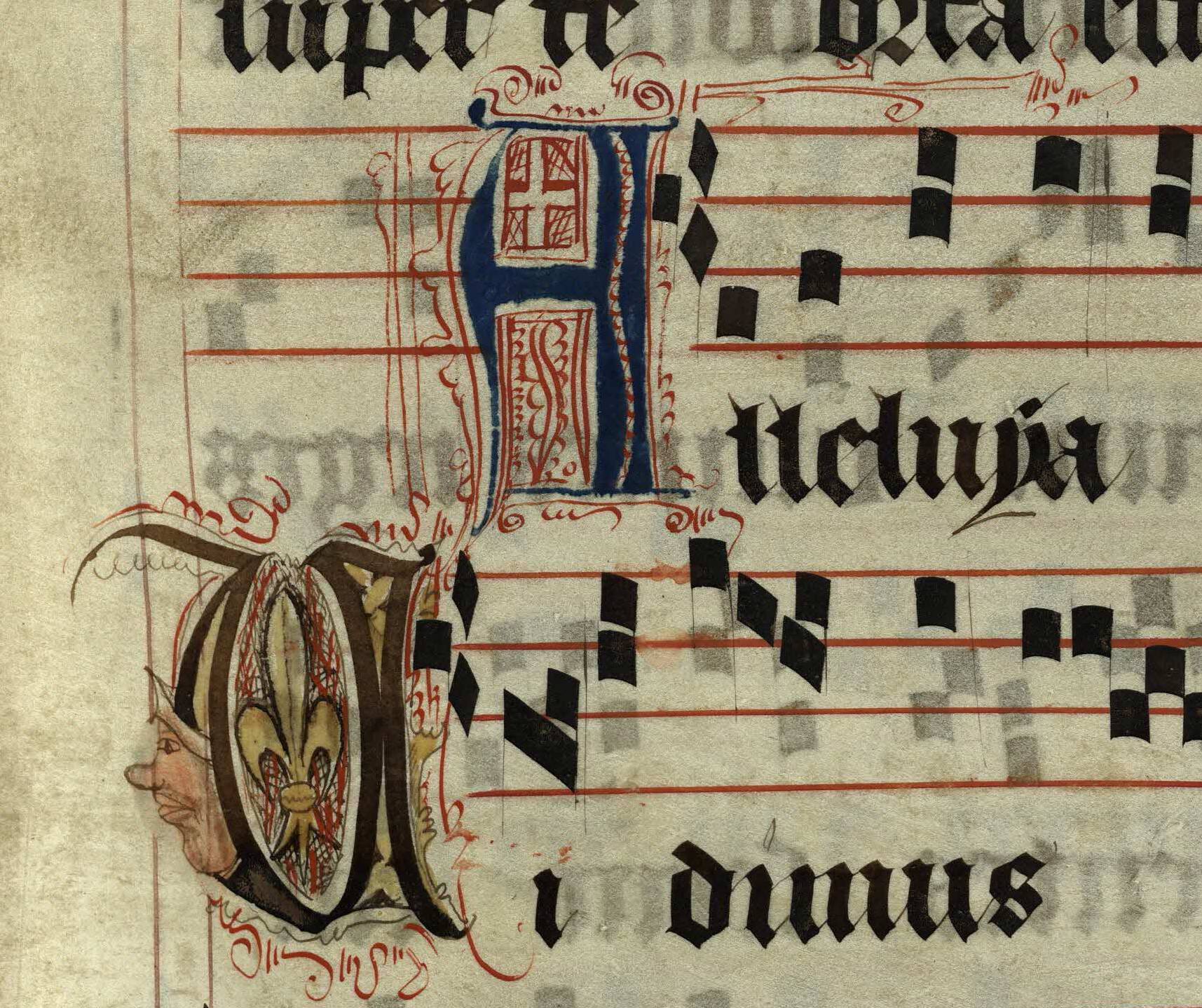52 Weeks of Inspiring Illustrations, Week 43: Faces, fauna, flora and St Francis: funny things lurking in a medieval music manuscript
I didn’t intend to write about the gradual at all for this post, I just happened to be looking at it one day when it was out for Tom Wilkinson the chapel organist to see. He is going to conduct the chapel choir in singing one of the Kyrie settings for a celebration service on 21st April for the 500th anniversary of the foundation of St Leonards College.

It’s not an easy book to just get out casually for a look, being our second heaviest manuscript, longer but not as thick as the works of Augustine of Hippo, so I was taking the opportunity of a peak and became fascinated by the inventiveness of the artist or artists who created the initials. For instance look at the many different forms of A and D, common because of the words Alleluia and Dominus appear so frequently in the Mass:







Also the wonderful creativity of simple ink lines in the R and the Q and a variety of S:



There are inhabited initials, with faces or people in them; zoomorphic initials, which have animals in them, mainly rather floppy looking dog-like creatures, although there is one that looks like Nessie; and decorated initials, with the fleur-de-lis being a common motif, as well as abstract designs based on trees, leaves, flowers, chevrons, stripes and bubbles.




The colour palette is limited – black embellished with yellow, or blue and red, with a pink wash giving many of the faces a ruddy glow. The faces are all very distinctive suggesting they could have been portraits of living people, other friars or even self-portraits perhaps. Some of them have their tongues out or scowl at us, others hide behind the downstroke or in corners or either side of a curve; one shares the letter with a fish, another with a serpent.


The gradual is a choir book of Gregorian plainchant, large enough for a group of choristers to gather around to sing the daily mass, divine offices and for special services in the Roman liturgical rite. Our gradual contains antiphons, introits, psalms, offertories and tracts for daily religious life in a monastery in the Middle Ages as they worked their way through the church calendar. It is on parchment, bound in white leather over very thick oak boards, and dates from around 1400.

It was given to the University Library in 1894 by local MP Stephen Williamson, but we have no information on where he got it from or where it had been before that. It was very probably created in a Franciscan friary, as a number of Franciscan saints days are celebrated including St Francis, his companion Antony of Padua, St Clare of the Poor Clares, and Bonaventura. A French origin is suggested by the fleur-de-lis motif which links it with the Angevin royal house, patrons and benefactors of the Franciscan order. There are instructions to the fratribus and fratres (brothers or friars) in the text and an interlinear gloss Beati Francisci has been added.

At the Feast of St Francis, the initial O of O patriarcha pauperum francisce contains St Francis himself, in front of a church on Mount Alverno, in the traditional pose with palms raised for the stigmata and a winged Christ on the cross in the background. It’s not a very sophisticated drawing but it makes the point.

As well as St Francis, an inhabited initial missed by Ker and Piper contains a sketch of the apostles, full of fearful trepidation, receiving the Holy Spirit as tongues of fire at Pentecost, in the initial V of Veni sancte Spiritus, reple tuorum corda fidelium, et tui amoris in eis ignem accende (Come, Holy Spirit, fill the hearts of Thy faithful and kindle in them the fire of Thy love), the traditional invocation of the Holy Spirit at Pentecost. You can just make out 11 of them.
This is a beautiful manuscript which repays detailed examination and I’m sure has more stories to tell. It will be exciting to hear a chant from this very volume sung here in St Andrews more than 600 years after it was written down on this parchment and decorated with these intriguing initials. That will really bring the manuscript to life.
–Maia Sheridan
Manuscripts Archivist
The people in this world, who are lucky enough to study, fondle and converse about such beautiful objects, are among the most fortunate of us all. Thank you for continuing to share!
Reblogged this on The Victorian Librarian and commented: If you are not already following the entertaining work of the St Andrews University Library Special Collections Department on their "Echoes from the Vaults" blog, I highly recommend that you do so. Go. Go now! This entry from a couple of days ago is all about the eco-system of medieval manuscript illumination, where all manner of characters and plants can be found in the initials and margins of each page, living their often strange and fascinating little lives. The drawings in this example, a 15th-century gradual, give some clues as to the text's origins.
[…] Gradual, which is featured in week 43 of our inspiring illustrations blog, is a choir book of Gregorian plainchant, large enough for a group of choristers to gather around […]